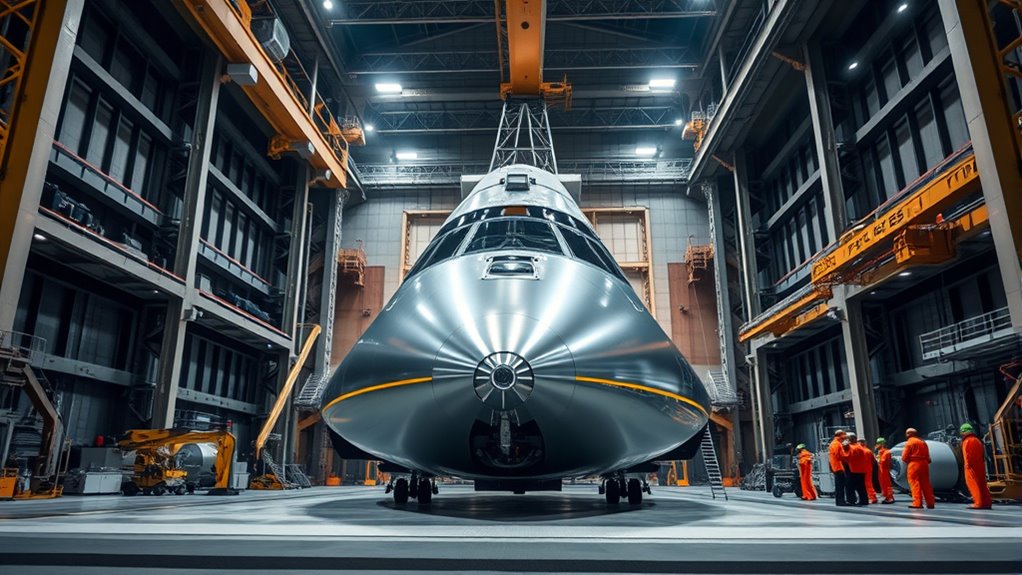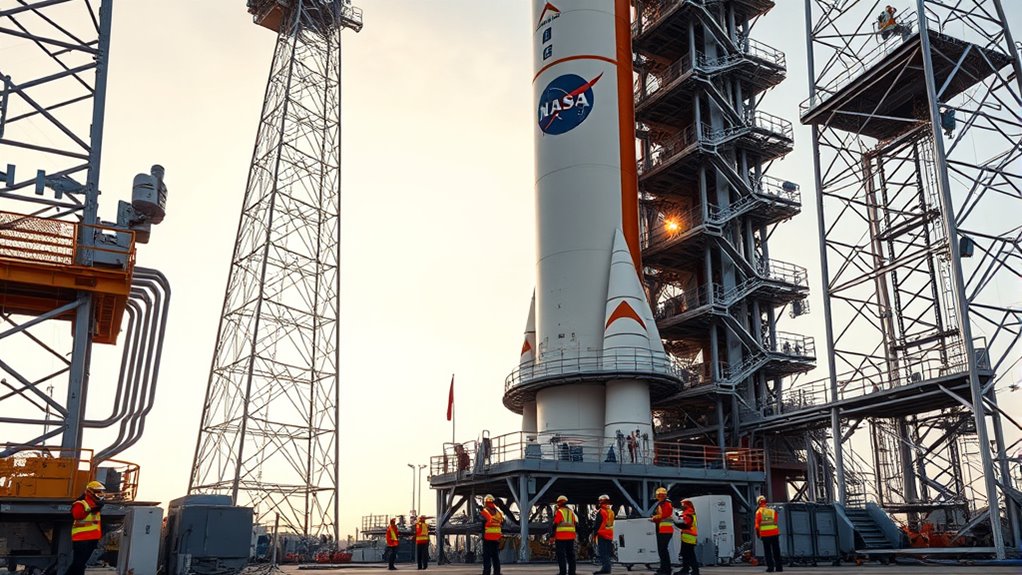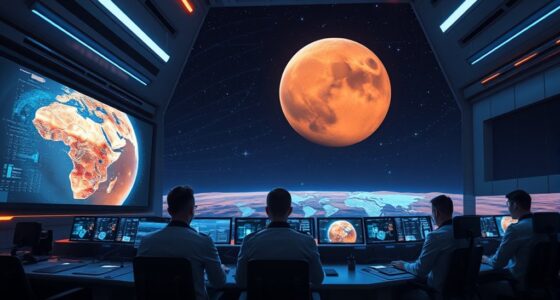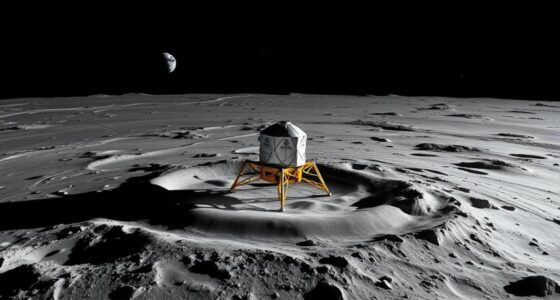NASA is actively preparing for the Artemis II moon mission, which will be the first crewed lunar flight since Apollo. They’re testing spacecraft systems like heat shields, navigation, and life support to make sure everything performs perfectly. Launch operations are being coordinated carefully to guarantee a safe and successful trip around the Moon. If you keep exploring, you’ll discover the exciting details behind this historic mission and what it means for the future of space exploration.
Key Takeaways
- NASA is finalizing preparations for the Artemis II mission, which will send astronauts around the Moon aboard the Orion spacecraft.
- Extensive spacecraft testing ensures all systems, including heat shields and navigation, are ready for lunar environment conditions.
- Final system checks and mission simulations are underway to ensure crew safety and mission success.
- The mission aims to validate Orion’s performance and demonstrate human capabilities for future lunar exploration.
- Artemis II represents a historic step toward establishing sustainable human presence on the Moon.

NASA is preparing for its upcoming Artemis II mission, aiming to send astronauts around the Moon for the first time since the Apollo era. This mission marks a significant milestone in space exploration, and you can feel the buzz of anticipation building as all systems move closer to readiness. Central to this effort is spacecraft testing, a vital step that guarantees every component of the Orion spacecraft performs flawlessly under the demanding conditions of lunar travel. During these tests, engineers scrutinize everything from the spacecraft’s heat shields to navigation systems, simulating the intense environments it will encounter. These rigorous procedures help identify and resolve potential issues before launch, giving you confidence that the mission will go smoothly. The spacecraft testing phase also involves verifying the integration of all systems—life support, communication, propulsion—to make sure they work harmoniously. You can imagine how detailed and painstaking this process is, with each test designed to replicate real mission scenarios. It’s a meticulous dance of checks and balances, essential for safeguarding the crew and mission success.
In addition, incorporating various educational toys into STEM outreach programs can inspire future generations of scientists and engineers by engaging them in space exploration concepts.
As you follow the preparations, it becomes clear that understanding the mission objectives is key to appreciating the significance of this endeavor. The primary goal of Artemis II is to validate the Orion spacecraft’s capabilities for crewed lunar missions, serving as a critical stepping stone toward future lunar surface landings. Unlike previous unmanned tests, this mission involves astronauts traveling in the spacecraft, testing life support systems, navigation, and communication in real-time. The crew will orbit the Moon, gather valuable scientific data, and demonstrate the spacecraft’s ability to operate reliably over extended periods in deep space. By achieving these objectives, NASA aims to build confidence in its lunar exploration architecture, paving the way for sustained human presence on the Moon. You’ll see that each phase of the mission aligns with broader goals—advancing technology, fostering international partnerships, and inspiring future generations. The mission objectives also include testing emergency procedures and making certain that the crew can safely return to Earth, which underscores the importance of thorough spacecraft testing and planning.
All these steps, from spacecraft testing to mission objectives, are designed with one ultimate purpose: to push the boundaries of human exploration and establish a sustainable presence on the Moon. As launch day approaches, you’re reminded that this mission isn’t just about reaching the Moon—it’s about paving the way for future explorers and opening the door to the mysteries of our nearest celestial neighbor. Every test, every system check, and every mission objective met brings you closer to witnessing history in the making.
Frequently Asked Questions
What Is the Expected Launch Date for Artemis II?
You should mark your calendar for late 2024, as NASA aims to launch Artemis II around that time. The mission timeline depends on successful testing of the spacecraft design, which is vital for crew safety. NASA is working diligently to guarantee all systems are ready, meaning the launch date might shift slightly. Stay tuned for updates, but you can expect the crewed lunar mission to happen in the latter part of 2024.
How Many Astronauts Will Be Onboard Artemis II?
You’ll have four astronauts onboard Artemis II, a crew composition that highlights NASA’s focus on diverse expertise. During astronaut training, they undergo rigorous preparation to handle every aspect of the mission, from launch to lunar orbit. This team’s combined experience is impressive, ensuring a safe and successful journey. With such a well-trained crew, Artemis II promises to push the boundaries of human space exploration and inspire future missions.
What New Technology Is Being Tested During This Mission?
During this mission, you’ll see new spacecraft sensors being tested to improve navigation and safety, making future missions more reliable. Additionally, advanced propulsion systems are put through their paces to enhance efficiency and speed, ensuring smoother travel to the Moon. These innovations aim to push the boundaries of current technology, helping you explore space more safely and effectively on Artemis II and beyond.
How Long Will the Artemis II Lunar Flyby Last?
You’ll be amazed to know that the Artemis II lunar flyby will last approximately 10 days, immersing the crew in a lunar orbit that pushes the boundaries of human exploration. During this mission duration, astronauts will orbit the Moon before heading back to Earth. This journey marks a groundbreaking step in space travel, combining cutting-edge technology with intense mission planning to guarantee safety and success.
Will There Be a Live Broadcast of the Mission?
Yes, there will be a live broadcast of the mission. You can access mission coverage through NASA’s official channels, including their website and social media platforms. The broadcast will be accessible to a global audience, allowing you to follow the Artemis II lunar flyby in real-time. Keep an eye out for updates on broadcast schedules, so you don’t miss any exciting moments of this historic mission.
Conclusion
As you watch NASA prepare for Artemis II, remember this is your Apollo moment—your chance to witness history in the making. Just like Apollo sparked a new era of exploration, Artemis II promises to push boundaries and inspire generations. The journey to the Moon isn’t just NASA’s; it’s a proof to human curiosity and courage. Stay tuned, because this mission is about to take you closer to the stars than ever before.









